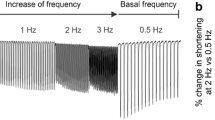Abstract
Hypoxia, ischemia and reoxygenation cause contractile dysfunction which will be characterized by the time course of isometric contraction of human atrial trabeculae. Post-rest potentiation (PRP) and postextrastimulatory potentiation (PEP) were elicited to obtain indirect information about the role of the sarcoplasmic reticulum (SR) in excitation-contraction coupling. As lipid peroxidation could cause SR dysfunction, thiobarbituric acid reactive substances (TBARS) were measured. After 30 min of hypoxia (H) or simulated ischemia (H combined with acidosis-SI), contractile force decreased to 15% and 6%, respectively, of control (p <- 0.05), whereas the normalized rate of both contraction and relaxation increased. In group H, rapid reoxygenation produced a recovery of contractile force to about 60%. After post-hypoxic reoxygenation the TBARS concentration was increased. In group SI, rapid reoxygenation and a rather gradual correction of acidosis produced complete recovery of contractile force. PRP and PEP were maintained during H and SI. Particularly post-ischemic reoxygenation caused a marked depression of PRP and partly of PEP. Thus, alteration of SR Ca2+ handling occurs predominantly during reoxygenation rather than during H or SI, probably associated with the damaging effect of increased oxygen radicals. The depression of potentiation occured along with delayed relaxation, temporary increased resting force, mechanical alternans, and spontaneous activity which are further characteristics for SR dysfunction. Thus, for a possibly beneficial effect of low pH during SI combined with its gradual correction during reoxygenation on the recovery of contractile function, developed force should not be the only index.
Similar content being viewed by others
References
Allen DG, Orchard CH: Myocardial contractile function during ischemia and hypoxia. Circ Res 60: 153–168, 1987
Hearse DJ, Belli R: Reperfusion induced injury: manifestations, mechanisms, and clinical relevance. Cardiovasc Res 26: 101–108, 1992
Pierce GN, Czubryt MP: The contribution of ionic imbalance to ischemia/reperfusion-induced injury. J Mol Cell Cardiol 27: 53–63, 1995
Silverman HS, Stern MD: Ionic basic of ischaemic cardiac injury: insights from cellular studies. Cardiovasc Res 28: 581–597, 1994
Tani M: Mechanisms of Ca2+ overload in reperfused ischemic myocardium. Ann Rev Physiol 52: 543–559, 1990
Goldstein JA, Tweddell J, Barzilai B, Yagi Y, Jaffe AS, Cox JL: Right atrial ischemia exacerbates hemodynamic compromise associated with experimental right ventricular dysfunction. JACC 18: 1564–1572, 1991
Kesler DF, Galyanov M, Zhukov KG: Diastolic function in patients with coronary artery disease: Effect of angina and heart failure functional class. Int J Cardiol 47: 211–215, 1995
Mubagwa K: Sarcoplasmic reticulum function during myocardial ischaemia and reperfusion. Cardiovasc Res 30: 166–175, 1995
Lazdunski M, Frelin C, Vigne P: The sodium/hydrogen exchange system in cardiac cells: Its biochemical and pharmacological properties and its role in regulating internal concentrations of sodium and internal pH. J Mol Cell Cardiol 17: 1029–1042, 1985
Orchard CH, Cingolani HE: Acidosis and arrhythmias in cardiac muscle. Cardiovasc Res 28: 1312–1319, 1994
Wilde MM, Aksnes G: Myocardial potassium loss and cell depolarisation in ischaemia and hypoxia. Cardiovasc Res 29: 1–15, 1995
Harada K, Franklin A, Johnson RG, Grossman W, Morgan JP: Acidemia and hypernatremia enhance postischemic recovery of excitation-contraction coupling. Circ Res 74: 1197–1209, 1994
Poole-Wilson PA: Regulation of intracellular pH in the myocardium; relevance to pathology. Mol Cell Biochem 89: 151–155, 1989
Mattheussen M, Mubagwa K, Rusy BF, Van Aken H, Flameng W: Potentiated state contractions in isolated hearts: Effects of ischemia and reperfusion. Am J Physiol 264: H1663–1673, 1993
Tatsumi T, Asayama J, Yamahara Y, Mijazaki H, Inoue M, Omori I, Inoue D, Nakagawa M: Effects of hypoxia and reoxygenation on regular contractions and postrest contraction in rat papillary muscles. Jpn Heart J 23: 363–371, 1991
Van Hardefeld C, Schouten VJA, Muller A, Van Der Meulen ET, Elzinga G: Exposure of energy depleted rat trabeculae to low pH improves contractile recovery: role of Calcium. Am J Physiol 268: H1510-H1520, 1995
Hata K, Takasago T, Saeki A, Nishioka T, Goto Y. Stunned myocardium after rapid correction of acidosis. Circ Res 74: 79–805, 1994
Goldhaber JI, Weiss JN: Oxygen free radicals and cardiac reperfusion abnormalities. Hypertension 20: 118–127, 1992
Ohkawa H, Ohishi N, Yagi K: Assay for lipid peroxides in animal tissue by thiobarbituric acid reaction. J Anal Biochem 95: 351–358, 1979
Luciani GB, D'Agnolo A, Mazzuco A, Galucci V, Salviati G: Effects of ischemia on sarcoplasmic reticulum and contractile myofilament activity in human myocardium. Am J Physiol 265: H1334–1341, 1993
Zucchi R, Testom S, Ronca G, Calafiore AM, Barsotti A, Mariam M: Sarcoplasmic reticulum Calcium uptake in reperfused human myocardium. Proc Internat Soc Heart Res (Mondüzzi Editore): 493–495, XV Eiirop Section Meeting (Denmark) 1994
Nwasokwa O N: Mechanism of mechanical alternans in ischemiareperfusion: Role of deficient relaxation of the strong twitch. Am J Physiol 269: H169-H175, 1995
Orchard CH, Kentish JC: Effects of changes of pH on the contractile function of cardiac muscle. Am J Physiol 258: C967-C981, 1990
Lammerich A, Günther J, Storch E: Interpretation of the inotropic effect of 2,3-butanedione monoxime on the isometric twitch of guinea pig papillary muscle. Gen Physiol Biophys 13: 377–392, 1994
Gross TH, Günther J, Storch E: The isometric twitch of rabbit papillary muscle: Reflection of the cellular Calcium movements? Gen Physiol Biophys 6: 521–538, 1989
Lammerich A, Günther J, Pfitzer G, Storch E, Vetter R: Alterations of cardiac contractile function are related to changes in membrane Calcium transport in spontaneously hypertensive rats. J Hypertension 13: 1313–1324, 1995
Holmberg SRM, Cumming DVE, Kusama Y, Hearse DJ, Poole-Wilson PA, Shattock MJ, Williams AJ: Reactive oxygen species modify the structure and function of the cardiac sarcoplasmic reticulum calciumrelease channel. Cardioscience 2: 19–25, 1991
Hohl CM, Garleb M; Altschuld RA: Effects of simulated ischaemia and reperfusion on the sarcoplasmic reticulum of digitonin-lysed cardiomyocytes. Circ Res 70: 716–723, 1992
Author information
Authors and Affiliations
Rights and permissions
About this article
Cite this article
Lammerich, A., Bohm, J., Schimke, I. et al. Effects of hypoxia, simulated ischemia and reoxygenation on the contractile function of human atrial trabeculae. Mol Cell Biochem 160, 143–151 (1996). https://doi.org/10.1007/BF00240044
Issue Date:
DOI: https://doi.org/10.1007/BF00240044




